PRASANTHI NEWS
18th February 2005
 This
evening, Swami came out for Darshan at 3.55. He took a full
round and then came and sat down on the sofa. As He looked
at the students seated in front, His eyes fell on a boy holding
a letter. Bhagawan signalled to him and the boy went forward
with the letter. As Swami took his letter, another boy who
was also eagerly waiting with a letter, also got an indication
from Swami. He too went forward. Looking at this, one by one,
students having a letter in their hand started moving forward. This
evening, Swami came out for Darshan at 3.55. He took a full
round and then came and sat down on the sofa. As He looked
at the students seated in front, His eyes fell on a boy holding
a letter. Bhagawan signalled to him and the boy went forward
with the letter. As Swami took his letter, another boy who
was also eagerly waiting with a letter, also got an indication
from Swami. He too went forward. Looking at this, one by one,
students having a letter in their hand started moving forward.
Bhagawan took each one of them and also had
a word with most of them. Minutes ticked by. The Music College
students were ready with their presentation for the evening.
At 4.15 p.m. Swami asked the Vedam chanting to be stopped.
The Principal of the Music College came and sat down next
to Swami’s sofa. What ensued was virtually a cascade
of Carnatic music recital one after the other by a group of
boys from the Music College – Rama Rama Rama Sita
Rama Eni Ro…, Jagadodarana Adisida Yasoda…
After this song, another student of Hindustani music, rendered
the song Wo Kala Eka Bansuri Wala Suda Bisaragaya Mori
Re… After two more songs, Bhagawan signalled to
one of the boys seated behind, a Sitar player to come forward
along with another boy to make their presentation.
It was 4.45 p.m. For the next 15 minutes
these two students enraptured the audience with Sitar music.
This was again followed by two more Carnatic songs –
Innu Dayabarade Dasana Mele and Mokshamu Galada Bhuvilo…
At 5.15 p.m., Bhagawan stood up and indicated for the Arati
to be performed. Then Bhagawan retired to His abode.
19th February 2005
This evening, Bhagawan came out for Darshan at 3.05 p.m.
As soon as Swami reached the portico of the Mandir, He spoke
to an Mrudangam artiste who was seated there along with the
Principal of Music College. Sri Umayalpuram K. Sivaraman,
a very reputed artiste who has played for renowned singers
like Smt. M.S. Subbulakshmi, Sri Balamurali Krishna, Sri Ramanuja
Iyengar and others was asked by Bhagawan to give his performance.
Bhagawan asked the Music College Principal make arrangements
for the concert. Bhagawan went inside the interview room,
but came out again in ten minutes time. Meanwhile, the carpet
was spread on the dais, microphones were arranged and the
artistes came and took their positions.
It was 3.20 p.m. Sri Sivaraman offered a rose flower to Bhagawan.
He was followed by the Principal of Music College and other
students who were to accompany them in the presentation. The
Principal introduced the guest by saying that the Music College
was indeed blessed today on receiving an artiste of such eminence.
The students had benefited immensely by his interaction at
the college in the morning and now they were fortunate to
perform with him in the Divine Presence.
Sri Umayalpuram K. Sivaraman is a Padma Bhushan, winner of
the Sangeeta Kalanidhi of the Music Academy. This evening,
he played the Mrudangam in the Divine Presence, with the Principal
as the main singer supported by his student of the final year
Diploma course in music. Two other boys played on the Veena
and the Violin.
For the next 50 minutes, the devotees and students had a
real treat of the artiste’s virtuosity. Bhagawan was
keeping beat with His hands throughout the performance. At
4.10 p.m. Swami signalled Sri Sivaraman to come forward. Swami
honoured him with a Dhoti and Angavastram. Swami materialised
a gold bracelet and put it on his wrist. Meanwhile, the Principal
also came forward and received the honour. Swami spoke to
both of them for some time.
The artistes settled down in their seats.
Bhagawan’s sofa that was turned to face them during
the performance was turned towards the students again. Swami
received letters from some of the boys and He asked the Vedam
chanting to start again. Swami also blessed the boys who had
their birthday on this day. Ten minutes later, Bhagawan asked
a Bhajan singer from the II M.Sc class to sing some Kirtanas.
The student sang seven devotional songs. To mention a few
- Brochevaru Evarura Ninuvina, Shobhilu Saptaswara, Sarasa
Samagana... During the course of his rendering, Swami
called him and asked him to sing a specific song. Some interaction
went on between Bhagawan and the student, and he came back
to his seat and continued singing some more songs.
At 4.45 p.m. Swami asked the Bhajan singing students to commence
Bhajans. It was 4.50 p.m. when Swami was offered Arati and
then He retired for the day.
20th February 2005
Being Sunday, the students had come for Darshan. Bhagawan
came out for Darshan at 7.25 a.m. However, after taking a
full round of the Hall, He went into the interview room.
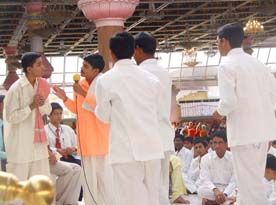 In
the evening, Bhagavan came out for Darshan at 3.05. This evening,
the XII class students were ready with their ‘Gratitude
Programme’. A number of students were seated with their
costumes in front of the dais. Swami took a full round and
as He came onto the dais, He enquired about the programme
from all seated over there. At 3.25 p.m., Bhagawan signalled
for the Veda chanting to be stopped. The XII class students
were to present a programme titled, Maa Jeevitame Mee
Sandeshamu – “Our Life is Your Message”. In
the evening, Bhagavan came out for Darshan at 3.05. This evening,
the XII class students were ready with their ‘Gratitude
Programme’. A number of students were seated with their
costumes in front of the dais. Swami took a full round and
as He came onto the dais, He enquired about the programme
from all seated over there. At 3.25 p.m., Bhagawan signalled
for the Veda chanting to be stopped. The XII class students
were to present a programme titled, Maa Jeevitame Mee
Sandeshamu – “Our Life is Your Message”.
The boys first offered a card to Bhagawan which explained
the salient features of the programme. The programme was well
presented. The main scene was about three accomplished gentlemen,
holding reputed positions in society, being interviewed for
a TV show. One was a doctor known for his service activities,
the second a CEO of a top company well known for his humanitarian
work and the third a singer who was using all his talent for
helping the needy as an offering to the Lord.
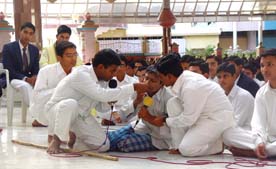 It
so happens that all the three are the alumni of the Sathya
Sai Institutions. Therefore, during the interview, they recall
several incidents at the School and also several experiences
of their classmates that went a long way in shaping their
lives and making them what they were today. Several experiences
were narrated in Telugu and even in Sanskrit. These were interspersed
with skits showing the loving manner in which these gentlemen
were welcomed into the Sathya Sai Hostel when they had come
there first as students. It
so happens that all the three are the alumni of the Sathya
Sai Institutions. Therefore, during the interview, they recall
several incidents at the School and also several experiences
of their classmates that went a long way in shaping their
lives and making them what they were today. Several experiences
were narrated in Telugu and even in Sanskrit. These were interspersed
with skits showing the loving manner in which these gentlemen
were welcomed into the Sathya Sai Hostel when they had come
there first as students.
There were also scenes of sick students being taken care
of in the Hostel, Grama Seva activities and its impact on
them, and so on. Yet another scene where the student gets
more marks on account of a totalling mistake and he confesses
it to the teacher, thus winning the praise and blessings of
the teacher.
At the end of the interview, the anchors praise the three
gentlemen for all their noble qualities and state that they
have truly accomplished fulfilment in their life. To this,
all the three respond saying that what they have done is hardly
anything. Bhagawan expects much more from them. What Swami
expects is that each one must seek the ultimate goal of life.
To illustrate this, they enact the scene from King Janaka’s
life, wherein he gets a dream. In the dream Janaka sees himself
as a commoner wandering in the forest, looking for water and
food. Finally, unable to bear the thirst and hunger, he gets
up with a scream, only to find his aide with a tray full of
food and drink!
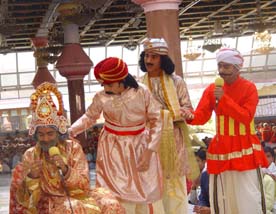 The
king is stunned and confused. He starts asking himself, “Is
this true or is that true? Edi Nijama Adi Nijama”.
No amount of attention paid by the minister or the royal doctor
helps the king to come back to his senses. He keeps on repeating
the above statement. Finally, Sage Yajnavalkya enters the
scene. Having known the happenings through his inner vision,
the sage explains to the king that neither is this true nor
is that true. It is he (the king) who experienced both the
states – the dream and the waking states. Therefore,
he alone is true. The king finally realises the Truth of the
Self. The
king is stunned and confused. He starts asking himself, “Is
this true or is that true? Edi Nijama Adi Nijama”.
No amount of attention paid by the minister or the royal doctor
helps the king to come back to his senses. He keeps on repeating
the above statement. Finally, Sage Yajnavalkya enters the
scene. Having known the happenings through his inner vision,
the sage explains to the king that neither is this true nor
is that true. It is he (the king) who experienced both the
states – the dream and the waking states. Therefore,
he alone is true. The king finally realises the Truth of the
Self.
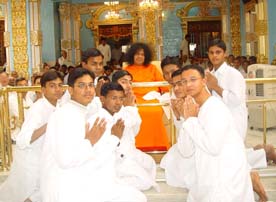 The
students concluded their presentation praying to Swami to
bless them with this grand Truth! There also sang a number
of group songs. As the final song began, Swami asked all of
them to arrange themselves for group photographs. Bhagawan
stood up and took a number of photographs with them. The
students concluded their presentation praying to Swami to
bless them with this grand Truth! There also sang a number
of group songs. As the final song began, Swami asked all of
them to arrange themselves for group photographs. Bhagawan
stood up and took a number of photographs with them.
At 4.25 p.m. Bhajans began and by 4.45 p.m. Swami was offered
Aarti and then Bhagavan retired for the day.
24th February 2005
This day was a very special day in the annals of the Institute
as it witnessed the change of leadership from one able instrument
of Bhagawan to another. Sri Anil Vinayak Gokak, the son of
the first Vice Chancellor of Sri Sathya Sai University, Sri
Vinayak Gokak, took over the reins of the Vice Chancellorship
of the University from Sri S.V. Giri.
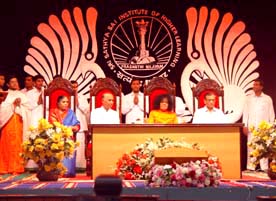 The
Institute Auditorium was beautifully decorated for the occasion.
Four thrones were placed on the stage. One at the centre for
Bhagawan, two on one side for Mr. and Mrs. S.V. Giri and one
on the other side for Mr. Anil Gokak. Two huge peacocks carved
from thermocol adorned the stage. The side flanks were beautifully
decorated with purple cloth twisted into elegant designs.
Huge flower vases adorned the stage as well as the pathway
at the entrance of the Auditorium. The
Institute Auditorium was beautifully decorated for the occasion.
Four thrones were placed on the stage. One at the centre for
Bhagawan, two on one side for Mr. and Mrs. S.V. Giri and one
on the other side for Mr. Anil Gokak. Two huge peacocks carved
from thermocol adorned the stage. The side flanks were beautifully
decorated with purple cloth twisted into elegant designs.
Huge flower vases adorned the stage as well as the pathway
at the entrance of the Auditorium.
At 7.55 a.m., Bhagawan arrived at the Auditorium. The Vedam
group started chanting Vedam and moved into the auditorium.
Bhagawan got down from the car and walked up a newly made
ramp into the Green Room at the North-East end of the Auditorium.
As Swami entered the Green Room and moved on to the stage,
the Vedam group was ready for receiving Bhagawan with Poorna
Kumbham and a rose flower.
Just as Bhagawan entered the stage, the Bhajans stopped and
the welcome song took over. By 8.00 a.m. Swami was seated
on His chair with the others seated next to Him.
At 8.05 a.m. the Vice Chancellor went to the podium and welcomed
Bhagawan and all the guests. He spoke for ten minutes followed
by a research scholar in the School of Business Management
and then by Sri Anil Gokak who delivered a brief 10 minute
address.
TALKS BY INCUMBENT
VICE CHANCELLOR, OUTGOING VICE CHANCELLOR AND A STUDENT
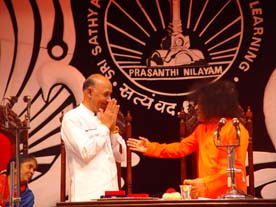 The
Vice Chancellor Sri S.V. Giri commenced his talk with the
chanting of verses from the Vishnu Sahasranamam. He stated
his inability to express his gratitude to Bhagawan for having
given him an opportunity to work for such a hallowed Institute
under Bhagawan’s direct guidance. The emphasis in this
Institute is on Character Building, with Vinayam (Humility),
Bhakti (Devotion) and Sraddha (Steadfastness) shaping the
personality of the students. Here Swami gives them the confidence
to face life and inspires them to develop compassion for all. The
Vice Chancellor Sri S.V. Giri commenced his talk with the
chanting of verses from the Vishnu Sahasranamam. He stated
his inability to express his gratitude to Bhagawan for having
given him an opportunity to work for such a hallowed Institute
under Bhagawan’s direct guidance. The emphasis in this
Institute is on Character Building, with Vinayam (Humility),
Bhakti (Devotion) and Sraddha (Steadfastness) shaping the
personality of the students. Here Swami gives them the confidence
to face life and inspires them to develop compassion for all.
He said that the five major efforts which the Institute has
been privileged to embark upon are
1) Seva – Service in all its forms. Free education,
free medicare, free water and service to society in all ways.
2) Veda Poshana – Recitation of the eternal verities
3) Deenodharana – Lifting the forlorn and downtrodden
4) Women’s Empowerment – Supporting women’s
freedom and empowerment
5) Caring of elders and aged – Bheema Ratha Shanthi
being an example.
These are the social manifestations of His Mission in which
students are used as instruments. He has given them the opportunity
to translate what He has in mind into reality and interpret
its significance to the rest of the world.
He concluded his talk by once again expressing his feeling
of inadequacy to show his gratitude to Bhagawan. He quoted
a Tamil poem which says that – “You thought that
I was of some worth, You chose me and you gave me the eyes
of wisdom to understand an iota of what you are; Oh Mother
what Grace of yours! How could this limited intellect of mine
ever comprehend your Grace!”
He said that With Swami there is no discharging the debt
of gratitude. Subsequently, the Vice Chancellor introduced
his successor Sri Anil Vinayak Gokak.
Sri Anil Vinayak Gokak held several responsible positions
both at the State and at the Centre. He belongs to the IAS
cadre of Maharashtra. He graduated from the Osmania University.
At the Central Government he held the post of the Cement Controller
of India, MD of Food Corporation of India and the position
of secretary in three important Ministries including Telecommunications
and Fertilizers.
He is the son of the illustrious father – Sri Vinayak
Gokak who described Bhagawan – our Chancellor as the
Divine Chancellor of the Universe. It was Sri Vinayak Gokak,
the first Vice Chancellor who enjoyed Bhagawan’s confidence
and was instrumental in drafting the rules and regulations
which hold till now as the best in the University. Sri Anil
Vinayak Gokak is a great speaker and is blessed to be the
7th Vice Chancellor of this sacred University.
Sri S.V. Giri then invited a Ph.D. Scholar from the School
of Business Management to share his thoughts with the audience.
Brother Sanjay began his talk by quoting the episode of the
inauguration of the Bukkapatnam High School, when Sri Kasturi
was sent an invitation to be the Chief Guest by Bhagawan.
In that invitation his name was mentioned as Dr. Kasturi.
Sri Kasturi Garu approached Swami and said that this was a
mistake as he did not have a Ph.D. To this Bhagawan said that
he indeed was a doctorate holder. Sri Kasturi humorously asked
Bhagawan, “From which University Swami?” Bhagawan
replied, “From the Puttaparthi University”. Sri
Kasturi Garu had a great laugh!
Least did he realise that when the Cosmic Consciousness –
Bhagawan speaks, it can never go in vain! Sri Kasturi Garu
did live to see this become a reality. Brother Sanjay went
on to highlight the achievements of the Institute during the
tenure of Sri S.V. Giri as the Vice Chancellor – a position
which he held from the 7th of August 1998 and served illustriously
in this capacity for the last six years.
The University scaled great heights under his leadership.
New courses such as the ‘Diploma in Indian Culture and
Philosophy’, the ‘Post Graduate in Economics’,
the ‘Master of Philosophy’ programme was started.
The Sathya Sai Mirpuri College of Music also came into existence
during his tenure in office. The Institute acquired total
connectivity with state-of-the-art infrastructure and Video-conferencing
between the Campuses, the Bio-Sciences department got the
‘Special Assistance Project’ from the UGC. The
National Conference for the Vice Chancellors for Education
in Human Values was held at Prasanthi Nilayam. The University
under the leadership of Sri S.V. Giri won nationwide acclaim.
Brother Sanjay corroborated his statements quoting from reports
of two committees that visited the Institute.
In January 2000, a committee headed by Sri M.K. Kaw visited
the University and stated, “The Sri Sathya Sai Institute
of Higher Learning is Bhagawan Baba’s outstanding contribution
to the world of learning. It is unique for it has integrated
value education with shining success since its inception.
All the gamut of activities that are carried out in this University
have one single underlying message and that is – education
is for life and not for a mere living.”
The Peer team of the National Assessment and Accreditation
Council that visited the University in December 2002 had this
to say, “The Sri Sathya Sai Institute of Higher Learning
is a crest jewel among the Universities of India and their
model is worthy of emulation by Universities in India and
elsewhere so that the benefits can be reaped fast and on as
wide a scale as possible.”
Brother Sanjay went on to say that great people are remembered
not just for what they do but what they are. Sri S.V. Giri
is known for his accessibility and the undivided attention
he gives for those whom he grants an audience. He personifies
humility and dignity. His very presence carries an aura of
dignity. He is a man of stupendous accomplishments but one
without the air of attainments. None have seen him lose his
temper or allow his emotions to get the better of him. He
is a man who always is in full control of himself.
Brother Sanjay praised the leadership of Sri S.V. Giri quoting
General Eisenhower who said that if you push a string from
behind it will go nowhere but if you pull it from the front
it will go anywhere. Leading from the front is the key! He
narrated an episode during the Grama Seva of 2000 wherein,
the Vice Chancellor had made it a point to visit a very far
off village, the road to which was almost impassable. But
he somehow made it to that remote hamlet, went around every
house asking them whether they had received Prasadam and then
also had a few words of encouragement for the students who
were assembled there. Students were left with great admiration
for him.
Another incident was during the Sports Meet of 2000 when
Bhagawan had allowed even staff members to participate. Early
morning, on the very first day, when a few staff members assembled
in the ground fighting the chilly weather, at 5.30 a.m., Sri
S.V. Giri was already there in his full sports gear ready
to encourage them.
He would be remembered as someone who could not possibly
always oblige for certain valid reasons, but always made the
listener very comfortable by obliging words. His keen interest
in the Awareness programme, to which he accorded utmost importance,
can never be forgotten.
As Sri S.V. Giri moved on to assume higher responsibilities,
Brother Sanjay recalled the statement made by Bhagawan on
the 4th of March 1993 when Sri Hanumanthappa was taking over
the Vice-Chancellorship of the University. Bhagawan said,
“With Swami, there is no send off. It is always welcome,
welcome and welcome!”
Sri Sanjay Mahalingam concluded his talk recalling the contribution
made by Sri Vinayak Gokak in building the foundation for this
University. Talking about the great person that Sri Gokak
was, he shared an incident that occurred long back. Once Sri
Vinayak Gokak was sitting on the benches of Trayee Brindavan
and he had just completed a book in Kannada. A friend of him
asked him as to when he would publish the book. To this Sri
Gokak asked him to look into the sky and tell him what he
saw. The friend replied that there were stars appearing in
the night sky. Sri Gokak said that these were not just stars
appearing but it was God composing His epic. The next morning,
there would be nothing. God composes His epic every evening
and erases it every morning. Does He care to publish it? He
acts out of the sheer joy of existence without any concern
for any appreciation or acknowledgement. Then why should we
worry about our accomplishments?
Today as Bhagawan’s Divine Mission enters its 80th
year and the Institute enters its 25th year, it is a great
fortune that the illustrious son of Sri Vinayak Gokak is taking
over the stewardship of the University. Under your guidance
and the Blessings of Bhagawan we hope to take this Institute
to far greater heights of glory! Last evening Swami made a
great statement. He said – Boys you all are blessed,
because one great Vice Chancellor is going and another great
Vice Chancellor is coming!
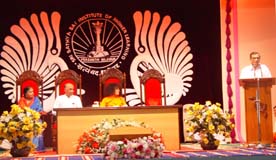 Brother
Sanjay’s talk was followed by Sri Anil Gokak. He sought
the guidance and inspiration of Sri S.V. Giri and Sri Chakravarthi
who were his senior colleagues in the IAS. He described the
Institute as an island of hope amidst chaos and a spiritual
lighthouse for the whole world. What distinguishes this great
Institution is the emphasis on Educare as separate from education.
Education as defined by Swami Vivekananda is truly Educare.
Educare is enabling the students to realise the Divine potential
within him. Man is not only Divine, he is also the acme of
creation for he alone has the ability to transform himself
from a beast into God. We need to find out whether we are
enabling this process. We are lucky to have the Divine incarnation
itself as our Guru. Brother
Sanjay’s talk was followed by Sri Anil Gokak. He sought
the guidance and inspiration of Sri S.V. Giri and Sri Chakravarthi
who were his senior colleagues in the IAS. He described the
Institute as an island of hope amidst chaos and a spiritual
lighthouse for the whole world. What distinguishes this great
Institution is the emphasis on Educare as separate from education.
Education as defined by Swami Vivekananda is truly Educare.
Educare is enabling the students to realise the Divine potential
within him. Man is not only Divine, he is also the acme of
creation for he alone has the ability to transform himself
from a beast into God. We need to find out whether we are
enabling this process. We are lucky to have the Divine incarnation
itself as our Guru.
However, this adds on a special responsibility on the teachers.
The teachers have to play a multifarious role over here. They
have to act as the snake charmer to wean away the minds of
the students from evil tendencies and be a shepherd to the
hungry sheep. Teachers are like the wire that connect the
Generator i.e. God with the students who are like the lamps.
The teacher has to carry the current within him so that it
reaches the other end and has the transforming effect.
He has to be the experiencer and not merely the transmitter
of the Divine Message. He has to identify the talents in the
students and accelerate them on the path that suits them best.
He has to communicate like a poet choosing an appropriate
medium, and then recreate the experience he has had, in the
minds of the students. All this must be done selflessly, without
any expectations and with pure motives. Teachers in this Institute
must be distinguished from their counterparts in other Institutes,
by the great quality of possessing nothing and seeking nothing.
We need to conduct a spiritual audit of ourselves to find
out whether we are transforming ourselves. This is the only
way to transform the students and restore our country to its
ancient glory and pride. He concluded his talk by seeking
Bhagawan’s guidance and encouragement and gave a word
that he would do his best to translate the objectives of the
Institute into reality.
At 8.50 a.m. the Vice Chancellor prayed to Swami to deliver
His Divine Discourse (given separately).
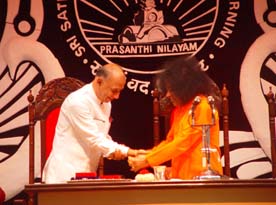 It
was 9.35 a.m. by the time Bhagawan concluded His Discourse.
Bhagawan blessed the Vice Chancellor by adorning his wrist
with a bracelet. Putting it round his wrist, Swami said, Edi
Prema Kankanam. He also blessed the wife of Sri S.V.
Giri with a similar bracelet and a necklace, which Swami asked
the Vice Chancellor to place round her wrist and neck. It
was 9.35 a.m. by the time Bhagawan concluded His Discourse.
Bhagawan blessed the Vice Chancellor by adorning his wrist
with a bracelet. Putting it round his wrist, Swami said, Edi
Prema Kankanam. He also blessed the wife of Sri S.V.
Giri with a similar bracelet and a necklace, which Swami asked
the Vice Chancellor to place round her wrist and neck.
Prasadam was distributed to all the students,
staff and guests. As the Arati concluded, Bhagawan got up
from the sofa and said that we must never forget chanting
Loka Samasta Sukhino Bhavantu. How can there be individual
welfare without universal welfare? World peace alone will
lead to individual peace. If you always chant Loka Samasta
Sukhino Bhavantu and if this feeling is there for the
welfare of the Loka, then the Lokeswara will always think
of your welfare too.
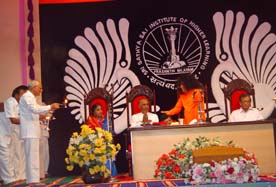 Bhagawan
retired to His abode at 9.45 a.m. In the evening, the 1st
year postgraduate students were ready with a special presentation
titled, Thyagenaike Amrutatva Manasuhu. Coincidentally,
or as we know by His Will, this play which they were planning
for many days turned out to be on the same theme on which
Swami spoke in the morning. Therefore, it proved to be a most
fitting programme for the evening. Bhagawan
retired to His abode at 9.45 a.m. In the evening, the 1st
year postgraduate students were ready with a special presentation
titled, Thyagenaike Amrutatva Manasuhu. Coincidentally,
or as we know by His Will, this play which they were planning
for many days turned out to be on the same theme on which
Swami spoke in the morning. Therefore, it proved to be a most
fitting programme for the evening.
Bhagawan, after giving Darshan at 3.00 p.m, directly went
into the interview room. After some time, Swami came out of
the interview room and asked the boys to start the programme.
Almost 60 of them were acting some role or the other while
the rest were working on the back stage.
Sai Kulwant Hall (4.10 p.m.)
A Play by the 1st year Postgraduate Students
“Thyagenaike Amrutatva Manasuhu”
The presentation began at 4.10 p.m. with
a dance choreographed to the song ‘Ekadantaya Vakratundaya
Gowritanayaya Dheemahi…’ as part of the Golden
Jubilee Celebrations of the Indian Arts Association. The backdrop
was simple but elegant. A screen of silk draping and a stage
in front of it with another silk curtain that could be drawn
apart when the performance would go on the stage.
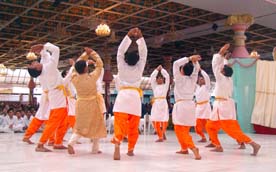 As
the dance draws to a close, the Director of the association
Sri Srivastava, announced a Nationwide Competition –
Art from Heart. This was open for all painters who could express
their talent on canvas. The best painting would fetch an award
of Rs.10 lakh and a tour around India to exhibit the paintings
and also an opportunity to work on the international stage
of art. As
the dance draws to a close, the Director of the association
Sri Srivastava, announced a Nationwide Competition –
Art from Heart. This was open for all painters who could express
their talent on canvas. The best painting would fetch an award
of Rs.10 lakh and a tour around India to exhibit the paintings
and also an opportunity to work on the international stage
of art.
In the next scene, a young budding painter by name Anand
discusses the competition with his financier and friend Mr.
Khanna. Mr. Khanna pumps up Anand and enthuses him to participate
in the competition to win the attractive award. Subsequently,
Anand goes to meet his Guru. He recalls how he had learnt
his first lesson of painting from his Guru 10 years ago.
The Guru advises Anand to open his heart to the sights and
sounds around so that he may learn several lessons. The Guru
says that his paintings were all impressions that had touched
his heart. Anand shares the news about the competition with
his Guru. Hearing about his plans to win the award and settle
abroad, the Guru gets furious. He reminds Anand that the land
on which he stood had nourished him all these years; he was
like a seed that had now grown into a full tree. Was it not
his duty to give shelter to this land now?
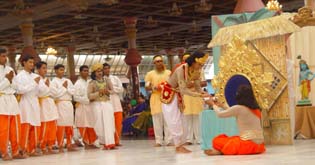 The
Guru bursts forth into a patriotic song – Sujalaam
Sufalaam Malayaja Sheetalaam Sasya Shyaamalaam Maataram Vande
Maataram … . Anand grows restless. He rebounds
and asks his Guru as to what this country had given him. Just
an award from the government? Had it given him a decent standard
of life? Had it given him any opportunities to develop his
talent? The
Guru bursts forth into a patriotic song – Sujalaam
Sufalaam Malayaja Sheetalaam Sasya Shyaamalaam Maataram Vande
Maataram … . Anand grows restless. He rebounds
and asks his Guru as to what this country had given him. Just
an award from the government? Had it given him a decent standard
of life? Had it given him any opportunities to develop his
talent?
Listening to his outburst, the Guru laments silently saying
that after all he belonged to the older generation and therefore
could not appreciate Anand’s views. He asks Anand to
go to the temple and deliver a packet to one Mr. Keshav Prasad.
As Anand leaves, the Guru prays to the Lord saying that Anand
had a heart of gold. God was after all the Goldsmith and should
therefore purify the heart of Anand and make him into a beautiful
ornament.
Anand goes to the temple and delivers the packet to Keshav
Prasad. Keshav Prasad opens the packet and distributes the
Prasadam to some poor people gathered outside the temple.
Anand watches all this. Meanwhile a very poor and starved
young man comes towards the temple seeking for some food.
He comes and prays to Anand to give him some money. Anand
drives him away mercilessly.
This starved man goes to the other poor man who is about
to eat the Prasadam given by Keshav. Looking at this starving
man, the poor man hands over the food to him with a smile
on his face. This comes as a shock to Anand. He is unable
to believe what he sees.
The next scene finds Anand talking to his grandpa. He narrates
all that he had witnessed to his grandfather. The grandfather
then explains to Anand the noble quality of sacrifice. He
says, giving away what you like and need most, with a smile
on your face, is true sacrifice. Our culture is replete with
such instances. Take for example the character of Karna in
the Mahabharatha.
The next scene depicts the story of how Lord Krishna, in
order to display the greatness of Karna to Arjuna, plays a
small drama. As Karna lies on the battle field wounded, Krishna
goes in the form a Brahmin seeking alms. He approaches Karna
but looking at his state decides to return. But Karna prays
to the Brahmin to ask for anything and he would grant it.
So long as there would be life in his body, he would never
send back any Brahmin empty handed.
Hearing this promise, the Brahmin says that as he had to
perform his son’s marriage, he needed some gold. Hearing
this, Karna feels miserable as he had no gold with him to
offer to the Brahmin. Therefore, he prays to the Brahmin to
go to Hastinapura and request his wife to offer him some gold.
The Brahmin expresses dissatisfaction saying that it was not
worth going all the way to Hastinapura, merely for a small
quantity of gold. The Brahmin is about to return when Karna
stops him. He decides to remove his gold tooth and give it
to the Brahmin. As he plucks out his gold tooth and offers
it, the Brahmin expresses anger that an offering soaked in
blood can never be accepted. Immediately, Karna shoots an
arrow into the sky bringing down rain that washes the tooth
of all the blood.
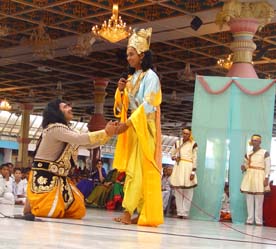 At
this instant, Lord Krishna manifests Himself, pleased with
the selfless sacrifice of Karna and asks him to pray for any
boon. Karna says that there could be no greater boon than
dying in the Lord’s Physical Presence. Karna offers
his heart to the Lord. At
this instant, Lord Krishna manifests Himself, pleased with
the selfless sacrifice of Karna and asks him to pray for any
boon. Karna says that there could be no greater boon than
dying in the Lord’s Physical Presence. Karna offers
his heart to the Lord.
The scene ends and back comes Anand. He is not convinced
still. Anand tells his grandfather that Karna had already
won so many laurels in life and therefore there was nothing
great in sacrificing at the end. But what about individuals
who are yet to bloom? What about their ambitions?
To this, the grandfather tells Anand the story of Khudiram
Bose who fought for the freedom of Mother India. When Mother
India was in chains so many youths offered their lives for
er cause. Their only ambition was to adorn their Mother with
the crown of freedom! The next scene took us to the pre-independence
years.
The patriotic fervour in the youth of those days was very
well depicted. Khudiram Bose rebels against the British and
throws a bomb at their office and runs away after that. However,
he is caught and handed over by a traitor to the British.
He is finally hanged to death. But his spirit lives on. He
prays to Mother India that he would be born again so as to
die once again for her sake. He asks her to remember him whenever
she saw any youth with a tricolour flag in his hands and a
noose round his neck! The scene was very touching and there
was a loud applause from the audience.
Anand too was touched. His heart gets transformed. He decides
to dedicate his life for the poor and the needy. He visits
the temple and serves food to the poor people assembled there.
Surprisingly, the Guru also comes over there and is surprised
to see Anand serving the poor. He enquires Anand about his
visa and passport arrangements..!!
Anand repents and confesses to his Guru that he was truly
lost in the materialism of life. The Guru knew that Anand
would turn a new leaf in his life. Anand, however was worried
about the funds that he would need for serving others. The
Guru reminds him of the painting competition. He explains
to Anand that God had blessed him with the talent of painting.
This was like Prasadam. Now this Prasadam of God must be offered
as Naivedyam to Him again. Therefore, the Guru enthuses Anand
to participate in the competition.
When Anand asks his Guru as to what he must
paint, the Guru asks Anand to consult his heart. Anand says
that his heart now chants just one mantra – Thyagenaike
Amrutatva Manasuhu… However, his heart still feels
empty.
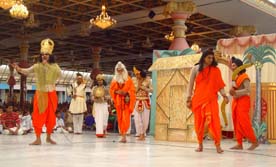 Meanwhile,
a Rama Leela play is about to be staged. The Mandir Pujari
calls all of them and they proceed to witness the play. This
scene shows the great sacrifice of Bharata who prays to Rama
to return to Ayodhya. Each one beats the other in their adherence
to sacrifice. Lord Rama holds on to His Dharma and refuses
to return to Ayodhya. Finally, Bharata takes the Padukas of
his brother Rama and places them on the throne as the symbol
of Lord Rama. Meanwhile,
a Rama Leela play is about to be staged. The Mandir Pujari
calls all of them and they proceed to witness the play. This
scene shows the great sacrifice of Bharata who prays to Rama
to return to Ayodhya. Each one beats the other in their adherence
to sacrifice. Lord Rama holds on to His Dharma and refuses
to return to Ayodhya. Finally, Bharata takes the Padukas of
his brother Rama and places them on the throne as the symbol
of Lord Rama.
Fourteen years later, when there is a slight delay in the
return of Lord Rama, Bharata is ready to end his life. However,
at the right time Hanuman comes in and gives the message of
Lord Rama’s arrival. Bharata, who by now looked just
like Rama, on account of his constant contemplation on Him,
hands over the kingdom back to Lord Rama.
The Guru explains to Anand the meaning of the word Bharata.
Bha means ‘Bhagawan’ and Rata means ‘to
please’. To please God, we must not only give up the
worldly comforts but we must give up our mind and our identity
too. Bharata had totally surrendered his mind to Lord Rama.
Finally, he lost even his identity and merged with the identity
of Lord Rama.
True sacrifice is giving up the evil qualities of life and
finally offering even the mind to God. Anand participates
in the competition. On the day of the award giving ceremony,
all paintings are arranged in the gallery. The scene is the
closing ceremony of the Golden Jubilee Celebrations of the
Indian Arts Association. Needless to say, the winner is none
other than Sri Anand. In the final scene, Mr. Anand comes
over to the mike and makes his award acceptance speech.
Anand makes a very wonderful presentation. He asks, as to
what is it that makes a mother give up all her comforts for
the sake of her child with a smile on her face? What is it
that inspires a father to present his son with a new pair
of shoes when he himself wears an old one with a sense of
joy and cheer? What is it that drives one poor man to share
his food with another hungry man, unmindful of his own burning
hunger?
That spirit, he declares, is the spirit of sacrifice. Sacrifice
is the language of Love. He accepts the award but dedicates
it for the welfare of the needy and the poor.
In the final scene, the boys pray to Bhagawan – the
very embodiment of sacrifice. They pray that all the sacrifices
He has made for His children must not go in vain and they
seek His blessings that their lives become His Message!
The presentation ended with the chanting
of Svasti Prajabhya Paripalayantam ...
It was 5.30 p.m. A one hour and twenty minutes drama came
to a close. There was a loud applause from the devotees. Swami
showered a lot of love and attention on all of them by posing
for photographs with them. He spoke to most of the characters.
Meanwhile, Prasadam distribution began. Special packets containing
three chocolates studded with dry fruits were distributed
to all devotes and students. Then Swami got into the golf
cart and retired for the day.
|






